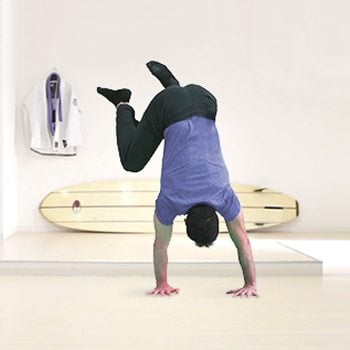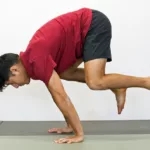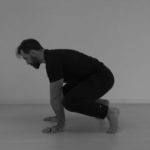 “Play” is a key element of the GMB philosophy, and it runs through all of our programming in some form or another.
“Play” is a key element of the GMB philosophy, and it runs through all of our programming in some form or another.
But what is play exactly?
We get questions quite often from people who don’t quite understand what we mean by “play,” and it’s understandable. As adults, we basically never play, so we’ve forgotten what it feels like. Often, we mistake “practice” for “play” but that’s really missing the point.
Here’s a snippet of what Andy had to say on the matter:
Practice happens at the edge of your ability; Play happens at the core of your competence.
In this episode, Andy and Ryan discuss what we mean when we talk about play. Watch and/or listen to get a clear understanding of playful movement and exploration.
- (01:22) “How the hell am I supposed to play with a movement if I’m just learning how to do it?”
- (09:37) The idea of play is to take a movement you’ve practiced and start to think outside the box. How can you take that move and expand it, explore with it?
- (10:26) The most difficult part of stringing two (or more) movements together is the transitional phase between point A and point B.
- (14:24) What practice means is that you work at it. What play means is that you play at it, and that you’re safe if you “screw up.”
- (15:00) We learn through our mistakes.
- (19:15) If you aren’t so creative and don’t really know how to “explore,” then copy other people’s movement combinations.
Andy: All right. Breaker, breaker one-niner on the interweb. Get your ears on for the GMB Fitness Skills Show. Over the next 30 minutes plus or minus, we’re going to be talking about how to get stronger, how to move better and how to be a better person because goddammit, that’s what really matters.
My name is Andy. Here with me Ryan Hurst, GMB’s head coach, all around badass and good guy.
Ryan: What’s up man? What’s up?
Andy: I’m all right. I’m all right. I’m wearing my horizontal stripes. So hopefully this will make me look a little fatter.
Ryan: Yeah, yeah. That’s what it’s about, yeah. I like it. That looks good there. Just the whole time.
Andy: And maybe if I could foreshorten this in the camera there, something like that. I don’t know. Anyway, so today we’re going to be talking about – what were we going to be talking about? Play and what it means. We talk about playing and the importance of play and exploration and you use the word “play” like it’s something that people should already know what the hell you’re already talking about. But a lot of them don’t and we get people asking us, “Well, how the hell how am I supposed to play with this when I’m just learning to do it?” or “How do you play with a push-up?” or stuff like that.
So we’re going to talk about play and we’re going to talk about Play’s good looking older brother Practice as well because you can’t have one without the other.
[Music]Andy: So before that, some things that have been going on. I was just talking to Nate Miyaki not long ago. Really great guy. If you want to know anything about fitness, nutrition, Nate is the man to listen to and actually Ryan was just saying you are officially back on the Nate Miyaki plan.
Ryan: Back on it, man. Back on it. So good stuff. Nate has been a friend of us for quite a while now and he has helped me out with my nutrition throughout the years. So I’m actually back on a plan that he’s doing for me. So I love it and it’s just – for me it’s very easy to do and what’s what I like about it as far as the lifestyle and of course it helps me to do what I need to do.
So if you don’t know anything about Nate, we will put a link in there so you can check Nate out, Nate’s information out. Really solid, solid stuff. Not just some kind of fad diet kind of thing.
Andy: No. So we should mention you haven’t been on Nate’s plan for a few months and so obviously we – just with training, there’s no nutrition plan that’s perfect for anyone. Everything – you have to adjust and find what’s appropriate for your goals. So obviously then something changed with your training lately.
Ryan: Right.
Andy: Without giving away the farm entirely, you want to talk about that for just a second?
Ryan: Yeah, I reevaluated my training and what was going on as far as recovery-wise and there’s so much stuff going on in my life. So I needed to take a look at how I could still work on my skills and do the things that I want to do without killing myself, without going crazy but basically more importantly, I just wasn’t getting the proper recovery that I needed.
So I made some changes to my programming which so far is looking very good. I’m a little bit reluctant to tell you exactly what I’m doing because it’s no secret. It’s not like there’s any secrets out there.
Andy: I will blab about it every – you cannot trust me.
Ryan: I just made some changes as far as how many times I was working out a day and …
Andy: Down from six.
Ryan: Down from six to five. That’s a big change. But changed up the nutrition and found something – well, not that I found but went back and actually talked to Nate and he helped me readjust some things to make sure that I was getting what I need and actually giving my body a break from eating so much in the morning because it was actually just – it wasn’t working for me and we found that – by this little change, it’s making a big difference for me right now. It’s just really cool.
So again, just like Andy mentioned, you got to find something that works for you and it might be seasonal. That’s another thing too. I don’t just jump from diet to diet. I’m on a nutrition plan for quite a while and then depending on what I change in my workouts, I also need to adjust my nutrition and so it’s like that really with everybody. If you’re doing it the way I’m doing it which basically because this is my job, I have to be careful and make sure that I am doing whatever I need to do in order to give me the results that I need. So thanks to Nate and his program. I’m now back on track and ready to go.
[Music]Andy: Yeah. I mean I also think that’s true for everyone really. You don’t have to be a professional athlete or a fitness professional or anything to focus on specific goals or to adjust your training or your nutrition or your lifestyle to things that are going on. We talk about general fitness, general physical preparedness, GPP, things like CrossFit or based on the whole idea that you have general fitness that you’re trying to achieve that just means stronger, better and faster, whatever, and it’s not specific to certain skills and there’s nothing terribly wrong with that.
We tend to focus on specific things but your life is always going to go through cycles and changes and if you have a busy phase at work because of a project or time of year, seasonal depending on what kind of work you do or if you have kids that have a school schedule that you have to change your lifestyle around, if you live some place unlike Hawaii where you have to – you don’t want to be outside for a few months of the year. I am pretty lucky. I’m wearing a sweater today because the AC is up so high.
Ryan: I’m wearing like six layers underneath it.
Andy: Right?
Ryan: But yeah, that’s a great point.
Andy: The point being though is we all have cycles and stuff. So you may not think that some of the things we talk about with cycling – oh, that’s not relevant to me because I’m not really working on a specialization, skill. I’m not that high level yet or whatever. The thing is, your life is in cycles already. Your lifestyle goes through cycles whether you choose to recognize it or not and personally I think that your training should fit your lifestyle cycles and if you have training goals that are cyclical, then you can try to match those up. But even if you don’t, even if you’re just doing general training, it should fit the cycles that naturally occur.
Ryan: Yeah. That’s good. So find something that will work with your lifestyle and do it.
Andy: Absolutely.
[Music]Andy: So let’s just get right into talking about play because this is something that’s kind of central to GMB. We started – from the very beginning, we were teaching – here’s exercises but you want to work towards a flow, routine, being able to put things together in a way and we made a flow of routines. But Ryan you always said from the very beginning that the ultimate goal is to be able to flow without a routine, to be able to move and transition and improvise and so it’s not – you learn the routine to be able to learn to improvise and my metaphor for that is always music but maybe something that people can relate to better and just what is play because people ask us all the time.
Ryan: Yeah. Play – depending on of course the person because if you look at children, let’s just look at children first and talk about play, what play is to children. The children, these are my kids, don’t have a defined movement pattern yet and what I mean by that is they don’t have these blinders of OK, this movement has to look this way or maybe even if they couldn’t do that movement, they don’t still have a concept of what anything is.
So they just move their bodies through space. So if they see something, they just try and climb up on it or they jump from the table to the bed or whatever they’re doing. OK? In their mind, that’s play.
When we talk about play, we’re talking about taking movements that we’ve practiced and that we’re very, very comfortable with and thinking of how to take those movements and expand upon those movements.
So rather than think about we’re going to do a cartwheel, we’re going to do exactly the way that we’ve been taught, we take that cartwheel that we’ve – I don’t want to use the term “mastered”. I don’t even – because I don’t think that we can master anything. I think we’re working towards that but we take a movement that we’ve practiced a lot and “practice” is the keyword. A lot of practice and we start to think out of the box. How can we take that cartwheel and expand, explore? See what other kind of movements we can do.
What if we do our head – what if we turn our head this way? What if instead of facing our hips this way, we turn to the outside? We explore. That is the meaning of play.
Now getting into where we’re trying to put movements together, this is where things can get difficult because we kind of have those blinders on and we forget that our bodies were meant to move. That’s kind of what we’re born to do because if you can’t move, you can’t be productive and there’s no point and we will just put you on the cliff and let you die.
So anyway, stringing two movements together and I’ve got two movements in the beginning. The most difficult part people have is the transitional phase, in between point A and B.
So it all comes back to practice, practice, practice, practice. Once you can understand one transition, let’s say – I want to keep it just very easy. Geez, I don’t even know. Walking, you’re walking, and then you do a lunge and you stand up and keep walking.
Pretty simple stuff but it’s amazing how many people have trouble stringing movements together. So when we talk about the play aspect, it’s not just running around and using the jungle gym and rolling around on the ground and doing silly stuff outside. That’s good. But when we talk about play, we talk about finding new options so that we can put things together in a better way that we haven’t performed before.
This is where it gets tough because I say having performed before. It’s not that we haven’t practiced each individual movement before. It’s that we’re trying to think of new ways to perform that movement.
[Music]Ryan: So play, again, if we could define it, I don’t know. You can help me out with something. Maybe – I don’t even want to use the term “freeform” because as soon as we start talking about freeform, people just start thinking that …
Andy: He’s doing whatever the hell.
Ryan: Yeah, whatever the hell I want to do and they just kind of miss it. I would say – oh my goodness. I don’t even know a good way because a lot of people mistake the practice and the play and again let’s just talk about practice one more time. Practice is focusing on one particular movement or a combination of movements in order to perform one pattern. So once you get that pattern down, the exploration of that pattern is the play. So …
Andy: So another way to look at that is let’s say that we take a skill that has different progressions, right? Like almost all the skills that we teach, right? There’s a beginner level and let’s just say there’s three. There’s a beginner, the middle, and the advanced level. There’s probably a lot more in between but just for the sake of simplicity, right?
So let’s say that you’ve been practicing for a while. You’ve made it through the beginner level and now you’re working on the middle level of the skill. Your practice is now the middle level. You don’t practice the beginner level very much anymore. You still come back to it, warm up with it, whatever. But your practice is the middle level.
But you probably can’t really achieve true play. You can’t – when you’re practicing on the middle level, you don’t have enough room. You don’t have enough leeway to play with it. It takes concentration. You might be at the limits of your mobility or your strengths and you just have to really work at it.
But that beginner level is much easier for you. So when you go back and you work and you do the beginner level, you will find that you don’t need as much concentration. It doesn’t take as much strength and you can then maybe play around with it and explore more. So, then the same thing happens when you move up to the advanced level for practice. Your play is going to be at the middle or the beginner level.
Both of those are areas you can play with. So it helps to think of it in that way. They’re not different skills. It’s not that you can play with some things and you can’t with others or some things are just exercises and some things are just dicking around. They all work on the same continuum and practice happens at the edge of your ability.
Ryan: Yes.
Andy: Play happens at the core of your competence and that’s really what the difference is. What practice is means you work at it. What play means is that you play at it and that you can explore different things and try things and you’re free to screw up because it’s not at the edge of your ability. It’s not dangerous for you to screw up at that level.
Ryan: That’s the big point. Through these screw-ups or these mistakes which actually aren’t even mistakes, because they’re just something that we’ve tried, that’s where you learn.
[Music]Ryan: By doing exactly what you said and taking that basic version or the version that you’re very comfortable with and playing with that, new things start to happen and through these mistakes and these new things that you see, then you start learning, then you start realizing, oh, this is possible. That’s what we’re after with play is looking at possibilities so that when we start moving on to something else, we can then add that into our toolbox of movements.
I always like what you say about music where you practice the scales in the beginning. You practice the notes but once you have those down, then you take what you’ve got, those notes, and try to string them together in a new way. You’re just playing with the notes. That’s where you start to create music and that’s what we’re doing here with GMB and all kinds of music.
So the basics are those scales, the notes that we’re looking at, and putting those together in a structured way so that we have some sort of a key that we can pull off of, and key I’m not talking about music key but actually having …
Andy: Like a legend.
Ryan: Legend, thank you. Yes. Then we can start taking pieces of that and exploring and trying to put those together. Now again, it doesn’t have to be multiple movements at the same time. It can just be one movement.
But that’s what we’re talking about play. So you see all these people recently and they’re performing these awesome movements and everything and just like wow. There’s this wow factor that’s huge right now. The only reason that they’re able to do that is because they have the basics down and they stepped up and said, “I’m going to play with these basics and see what else I can come up with and string things together.”
That’s what we’re talking about when you talk about play and some really beautiful things can happen from that and it doesn’t have to be at the advanced level nor should it if you’re not at that level.
Andy: Yeah, absolutely. So yeah, that’s what play is, folks. It’s taking the things that you’ve practiced, taking the things that are within your ability and then just exploring them without expectation of what the outcome is going to be and kind of seeing what comes up and there’s not a lot more we can do to explain it. It’s just like how do you explain to a child how to play with Legos?
Ryan: Yeah.
Andy: I mean you can show them how they fit together and everything. You can teach them how to read the instructions to make a spaceship but ultimately, they’re going to – they might make the spaceship or not but ultimately they’re going to just play with the damn blocks and they don’t need you to show them that.
Ryan: But you bring up – I mean that reminds me of when my kids when they were so little that they weren’t even able to hold that Lego. So first thing, they had to learn how to hold that Lego then they got to learn how to put them together. Then they can start building things and that’s exactly what we’re talking about.
So even children, it’s the same way. When my kids, when they play in the monkey bars now, they first had to learn how to hold on to the bar and then go from one bar to the other. So that’s play. That’s play.
[Music]Andy: You mentioned Legos. Like my daughter is just a year and a half and she has these big Duplo blocks and she just figured out how to stack them, right?
Ryan: Cool.
Andy: But you know what? She has had them for over a month now. She played with them the whole time. How does she play with them when she can’t stack them? She picked them up and she threw them. She would put them in a bucket and she dumped them out. She found things that she could do with them that that was her play at that level and now she can stack them up and so she’s starting to play with different ways to stack them up. So wherever you are with your movements or with your exercise or whatever, play for you depends on your own level and what’s comfortable for you and what you can then mess around with, so yeah.
Ryan: Nice, nice. That’s good. That’s good man. Yeah. We covered a lot here and I mean it is really hard to define exactly what it is and so – but I think you did bring up a good way to saying this, to practice your level at that basic level for you and you can play anyway you want really. It’s an exploration and figuring out what you can do with it.
Andy: Yeah. You’re only limited by your creativity in that and some people might think, “Well, I’m not creative.” Well, you know what? That’s why you watch other people who are and you copy their shit and when you try to do the things that other people are doing and you apply it to the level and the movements that you do it at, then you will come up with something that’s different.
If you watch somebody who’s advanced and you say, oh well, somebody from a back flip, the next step for them to play with it is to do a twisting flip or to do a back flip while they’re running forward or something like that.
So maybe you’re just working on squatting if that’s all you can do. Well, what if you squat and twist? What if you squat and walk forward? It’s the same things that you can apply to whatever movement. So if you think you’re not creative, copy somebody.
Ryan: It’s just like in music, same thing. Learning the guitar, you copy who you enjoy and then from that, we learn. That’s also how I learned language. I don’t know if you’re the same way but when I was in Niigata [0:20:10] [Phonetic], when I was university, I copied the way that my Kendo instructor spoke because he spoke very well and so once you learn that, then you can start making it your own and yeah, that’s the way to do it. All right man. Good stuff.
Andy: Well, so thanks for watching and listening and play with what you can play with. Don’t think that it’s something you have to wait until you’re advanced for. Play with what you can do. Throw the blocks. Put them in a bucket and show us what you got. I would love to see if you can come up with something that’s really – that’s interesting and fun for you, that uses just very basic stuff. So share it and that’s how we all enrich our experience and our creativity together.
Ryan: All right. Until next time. Later.
[End of transcript]Be sure to catch the next episode by subscribing to the GMB Show:


